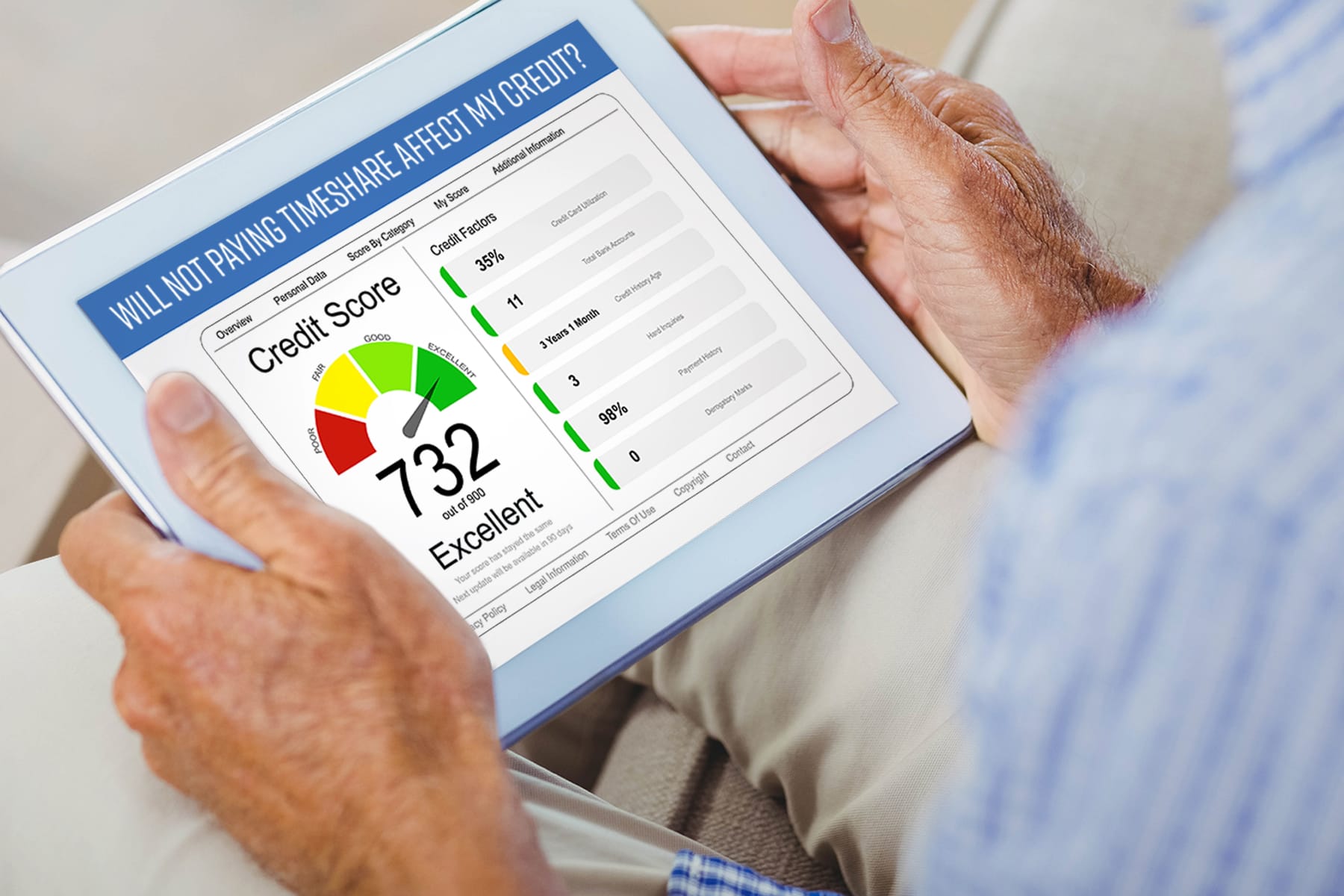Home>Finance>How Do I Remove Old Addresses From My Credit Report


Finance
How Do I Remove Old Addresses From My Credit Report
Published: October 20, 2023
Looking to improve your finances? Learn how to remove old addresses from your credit report and take control of your financial future.
(Many of the links in this article redirect to a specific reviewed product. Your purchase of these products through affiliate links helps to generate commission for LiveWell, at no extra cost. Learn more)
Table of Contents
- Introduction
- Understanding Credit Reports
- The Importance of Removing Old Addresses
- Step-by-Step Guide to Removing Old Addresses from Your Credit Report
- Method 1: Online Dispute
- Method 2: Dispute by Mail
- Method 3: Dispute by Phone
- Method 4: Dispute with a Credit Repair Company
- Method 5: Send a Goodwill Letter
- Method 6: Wait for Automatic Removal
- Tips for Successful Address Removal
- Conclusion
Introduction
Having accurate and up-to-date information on your credit report is crucial for maintaining a healthy financial profile. One common issue that many individuals face is the presence of old addresses on their credit reports. While it may seem like a minor concern, these outdated addresses can potentially lead to confusion, identity theft, or inaccurate credit assessments.
A credit report is a detailed summary of your borrowing history, payment patterns, and personal information. It serves as a record of your creditworthiness and is used by lenders, landlords, and potential employers to evaluate your financial behavior and responsibility. It includes personal information, such as your name, date of birth, social security number, and current and previous addresses.
However, over time, you may have moved residences, changed your mailing address, or updated your contact information. If you haven’t been proactive in updating your address with credit reporting agencies, your credit report may still reflect outdated information.
While an old address on your credit report may not directly impact your credit score, it can still lead to complications that may affect your financial well-being. For instance, if a potential lender sees an unfamiliar address linked to your credit history, they might question the accuracy of your application. It could also make it difficult for creditors to locate you if they need to send important information or documentation.
In addition, outdated addresses on your credit report can increase the risk of identity theft. If a fraudster gains access to your credit information and notices an old address, they may be able to use it to their advantage.
Fortunately, there are ways to remove old addresses from your credit report, ensuring that your credit information is accurate and up to date. In this article, we will explore the importance of removing old addresses and provide you with a step-by-step guide on how to achieve this. By following these steps, you can ensure that your credit report reflects your current address and minimize any potential confusion or risks associated with outdated information.
Understanding Credit Reports
Before delving into the process of removing old addresses from your credit report, it’s essential to understand what a credit report is and how it functions. A credit report is a detailed document that contains information about your financial history, including credit accounts, payment history, and personal information.
When you apply for credit, such as a loan, credit card, or mortgage, your potential lender will request a copy of your credit report from one of the major credit reporting agencies, such as Experian, Equifax, or TransUnion. These agencies gather information from various sources, including lenders, banks, and utility companies, to compile your credit report.
Your credit report contains several key components:
- Personal Information: This includes your name, date of birth, social security number, and current and previous addresses. It helps lenders verify your identity and track your credit history.
- Credit Accounts: This section lists all your active and closed credit accounts, including credit cards, loans, and mortgages. It details the account balances, credit limits, payment history, and any late or missed payments.
- Public Records: Public records, such as bankruptcies, tax liens, and court judgments, can significantly impact your creditworthiness and may remain on your report for several years.
- Inquiries: Whenever you apply for new credit, a record of the inquiry is added to your report. Multiple inquiries within a short period can have a negative impact on your credit score.
It’s important to note that credit reports are used by lenders and other entities to assess your creditworthiness and determine the risk associated with lending you money or extending credit. They play a crucial role in deciding whether to approve or deny your credit applications, establish interest rates, or set credit limits.
Regularly reviewing your credit report is essential to ensure the accuracy of the information and identify any errors or discrepancies that could negatively impact your creditworthiness. By understanding the components of a credit report, you will be better equipped to manage and maintain a positive credit profile.
The Importance of Removing Old Addresses
While old addresses may seem like a minor detail, it is crucial to remove them from your credit report for several reasons:
1. Accuracy of Information
Having accurate and up-to-date information on your credit report is essential. Outdated addresses can lead to confusion, especially if your current address differs from the one listed on your report. This discrepancy may raise red flags and create doubts regarding your identity and creditworthiness. By removing old addresses, you ensure that your credit report reflects your current and correct address.
2. Identity Theft Prevention
Old addresses on your credit report can increase the risk of identity theft. Fraudsters can potentially exploit outdated information to gain unauthorized access to your accounts or use it to create fraudulent accounts. By removing old addresses, you minimize the risk of someone misusing your personal information and reduces the likelihood of falling victim to identity theft.
3. Effective Communication
Keeping your address updated on your credit report allows creditors and financial institutions to reach you promptly when necessary. If a creditor needs to send important information or documentation, having your correct address ensures that you stay informed about any critical matters related to your credit accounts.
4. A Clean and Organized Credit Report
Removing old addresses helps maintain a clean and organized credit report. While it may not directly impact your credit score, having accurate and streamlined information demonstrates your attention to detail and responsible credit management. This can positively influence potential lenders when you apply for new credit or loans in the future.
5. Minimize Credit Assessment Delays
Outdated addresses on your credit report may lead to delays in credit assessments or applications. Lenders rely on accurate information to verify your identity and evaluate your creditworthiness. Any discrepancies or outdated details can slow down the process and potentially hinder your ability to secure credit or favorable terms.
Overall, removing old addresses from your credit report is essential for maintaining an accurate and reliable credit history. It ensures that your creditworthiness is assessed correctly, reduces the risk of identity theft, and facilitates effective communication with creditors and financial institutions.
Step-by-Step Guide to Removing Old Addresses from Your Credit Report
Removing old addresses from your credit report may seem like a daunting task, but with the right approach, it can be a straightforward process. Here’s a step-by-step guide to help you remove outdated addresses:
- Step 1: Obtain Your Credit Reports
- Step 2: Review Your Credit Reports
- Step 3: Contact the Credit Reporting Agencies
- Step 4: Provide Documentation
- Step 5: Follow-Up on the Dispute
- Step 6: Send a Letter to Creditors
- Step 7: Monitor Your Credit Report
Start by obtaining copies of your credit reports from the major credit reporting agencies – Experian, Equifax, and TransUnion. You are entitled to one free copy of your credit report from each agency annually. Visit annualcreditreport.com or contact the agencies directly to request your reports.
Carefully review each credit report to identify any outdated addresses listed. Make a note of which addresses need to be removed.
Reach out to the credit reporting agencies to dispute the outdated addresses. You can initiate the dispute online, by mail, or through phone. Each agency has their own process for handling disputes, so make sure you follow their specific instructions.
When disputing the addresses, provide documentation to support your claim of the outdated information. This could include a copy of your current driver’s license, utility bills, or lease agreements that clearly show your updated address.
After submitting the dispute, monitor the progress and follow up with the credit reporting agencies if necessary. They have a legal obligation to investigate and resolve your dispute within a reasonable timeframe.
In addition to disputing with the credit reporting agencies, send a letter to the creditors associated with the outdated addresses. Request that they update their records and remove the old addresses from their reporting as well.
Regularly monitor your credit reports to ensure that the outdated addresses have been removed. You can request a free copy of your credit report annually or consider using credit monitoring services to stay updated on any changes.
By following these steps, you can take control of your credit report and ensure that outdated addresses are removed promptly. Remember to be proactive and persistent during the process to ensure the accuracy and reliability of your credit information.
Method 1: Online Dispute
One of the most convenient ways to remove old addresses from your credit report is by utilizing the online dispute process provided by the major credit reporting agencies. Here’s how you can use this method:
- Access the Credit Reporting Agency’s Website
- Initiate the Dispute
- Provide Supporting Documentation
- Submit the Dispute
- Monitor the Dispute Status
- Follow Up if Needed
Visit the website of the credit reporting agency where you identified the outdated address. Typically, you can find a section dedicated to disputes or consumer assistance.
Look for the option to initiate a dispute online. Fill out the required information, including your personal details and the specific address you want to dispute.
Upload any supporting documentation that proves your current address and verifies the inaccuracy of the old address. This could include a copy of your driver’s license, utility bills, or lease agreements.
Once you have filled out the necessary information and attached supporting documentation, submit the dispute through the online platform. Note down any reference number or confirmation of the dispute for future reference.
Keep track of the dispute’s progress by regularly checking the status online. The credit reporting agency will investigate the dispute within a specific timeframe and update you accordingly.
If the outdated address is not removed from your credit report within the expected timeframe or if you haven’t received any response, follow up with the credit reporting agency to inquire about the status and request further action.
The online dispute process is often the quickest and most efficient method for addressing outdated addresses on your credit report. It allows you to provide necessary documentation easily and track the progress of your dispute. Remember to retain any confirmation or reference numbers provided during the process for future reference.
While online dispute is a convenient option, it’s not always the most effective. If the online dispute does not yield the desired results, you may want to consider alternative methods such as disputing by mail or phone, or seeking assistance from a credit repair company.
Method 2: Dispute by Mail
If you prefer a more traditional approach, you can opt to dispute old addresses on your credit report by mail. Here’s an easy step-by-step guide on how to use this method:
- Gather the Necessary Information
- Write a Letter
- Include Supporting Documentation
- Send the Dispute Letter
- Keep Copies and Records
- Monitor the Dispute Progress
- Follow Up if Needed
Collect all the required information, including your full name, address, social security number, and the specific outdated addresses you want to dispute.
Compose a formal letter addressing the credit reporting agency associated with the outdated address. Clearly explain the purpose of the letter, state the outdated addresses you want to dispute, and provide any relevant details to support your claim.
Enclose any supporting documentation that verifies your current address and proves the inaccuracy of the old addresses. This could be copies of your driver’s license, utility bills, or lease agreements.
Mail the dispute letter, along with the supporting documentation, to the address provided by the credit reporting agency. It’s recommended to send the letter via certified mail with a return receipt requested for proof of delivery.
Make copies of the dispute letter, supporting documentation, and any related correspondence. Keep these documents in a safe place for your records.
Allow the credit reporting agency sufficient time to investigate your dispute. You can contact them periodically to inquire about the status and ensure that the outdated addresses are being addressed.
If the outdated addresses are not removed within a reasonable timeframe or if you do not receive a response, follow up with the credit reporting agency to express your concerns and request further action.
Disputing old addresses by mail may require more time and effort compared to online disputes. However, it can be a valuable method if you prefer written communication or need to provide extensive supporting documentation. Remember to maintain copies of all correspondence and follow up if necessary to ensure the prompt resolution of your dispute.
If disputing by mail doesn’t yield the desired results, you may consider exploring other methods, such as disputing by phone, seeking assistance from a credit repair company, or trying a goodwill letter to address the outdated addresses on your credit report.
Method 3: Dispute by Phone
If you prefer a more immediate and interactive approach, you have the option to dispute old addresses on your credit report by phone. This method allows you to speak directly with a representative from the credit reporting agency. Here’s how you can use this method:
- Gather Your Information
- Call the Credit Reporting Agency
- Provide Your Details
- Clearly Explain the Dispute
- Engage in a Constructive Conversation
- Take Note of the Call Details
- Follow Up if Needed
Collect all the necessary information, including your full name, social security number, and the specific outdated addresses you want to dispute.
Obtain the phone number of the credit reporting agency associated with the outdated addresses. You can typically find this information on their website or on the credit report itself.
When you reach the representative, provide them with your personal information and state that you would like to dispute the outdated addresses on your credit report.
Articulate your concerns and clearly explain why the addresses are outdated. Be prepared to provide any supporting documentation or details that can help strengthen your case.
Engage in a respectful and constructive conversation with the representative. Ask questions, seek clarification, and ensure that they understand your concerns about the outdated addresses.
During the call, take notes of important details, such as the representative’s name, the date and time of the call, and any reference or confirmation numbers provided.
If the issue is not resolved immediately, ask about the expected timeframe for the resolution. Take note of any follow-up steps or actions required from your end and diligently follow up if necessary.
Disputing by phone provides a direct line of communication with the credit reporting agency, allowing you to explain the issue personally. It can be a quick and effective method for addressing outdated addresses on your credit report. Remember to be patient, firm, and polite during the conversation. Keep detailed notes for your records and follow up if the issue is not resolved in a timely manner.
If disputing by phone does not yield the desired results, you may want to consider alternative methods such as disputing online or by mail, seeking assistance from a credit repair company, or writing a goodwill letter to address the outdated addresses on your credit report.
Method 4: Dispute with a Credit Repair Company
If you find the process of disputing old addresses on your credit report overwhelming or time-consuming, you may consider seeking assistance from a credit repair company. These companies specialize in improving and managing credit profiles. Here’s how you can utilize their services:
- Research and Choose a Reputable Credit Repair Company
- Consultation and Enrollment
- Provide Necessary Information and Authorization
- Let the Credit Repair Company Handle the Dispute
- Stay Updated on Progress
- Monitor Your Credit Reports
- Follow Up and Provide Feedback
Take the time to research and select a reputable credit repair company. Look for companies with positive reviews, established track records, and clear pricing structures.
Contact the credit repair company and schedule a consultation. During this consultation, they will assess your credit situation, including the outdated addresses, and provide recommendations for improvement. If you decide to move forward, you will typically need to enroll in their services.
Once enrolled, you will need to provide the credit repair company with the necessary information, such as your credit reports and details of the outdated addresses. You will also need to authorize them to act on your behalf in the dispute process.
The credit repair company will take over the dispute process on your behalf. They will communicate with the credit reporting agencies and follow the necessary steps to remove the outdated addresses from your credit reports.
The credit repair company should provide regular updates on the progress of your disputes. Stay in touch with them and ask for updates as needed.
Continuously monitor your credit reports to ensure that the outdated addresses are being removed and that your credit profile is being improved as a result of the credit repair company’s efforts.
If you have any concerns or questions during the process, don’t hesitate to reach out to the credit repair company. Additionally, after the process is complete, provide feedback about your experience to help others make informed decisions.
Working with a credit repair company can provide peace of mind and save you time and effort in navigating the dispute process. However, it’s important to research and choose a reputable company and understand their fees and services before enrolling. Keep in mind that credit repair companies cannot guarantee specific outcomes or remove accurate information from your credit report.
If you prefer to handle the dispute process on your own, you may consider other methods such as disputing online, by mail, or by phone. Additionally, writing a goodwill letter can be another approach to address outdated addresses on your credit report.
Method 5: Send a Goodwill Letter
If you have been unable to remove old addresses from your credit report through other methods, you can try employing the strategy of sending a goodwill letter. A goodwill letter is a formal letter written to the credit reporting agencies or creditors requesting the removal of outdated addresses based on goodwill. Here’s how you can utilize this method:
- Format Your Goodwill Letter
- Explain the Reason for the Request
- Highlight Your Responsible Financial Behavior
- Request the Removal of Outdated Addresses
- Attach Supporting Documentation
- Send the Goodwill Letter
- Follow Up on the Letter
Compose a formal letter explaining your situation and the specific outdated addresses you want to remove. Use a polite and professional tone throughout the letter.
In your letter, provide a clear explanation of why the outdated addresses should be removed. For example, mention that the addresses are no longer relevant to your current living situation and can cause confusion or potential identity theft risks.
Emphasize your responsible financial behavior and positive credit history. Mention any accomplishments, such as consistently paying bills on time or successfully managing credit accounts.
Clearly state your request for the removal of the outdated addresses from your credit report. Politely ask for their understanding and consideration based on goodwill.
Include any supporting documentation that proves your current address and supports your claim that the outdated addresses should be removed. This could be copies of your driver’s license, utility bills, or lease agreements.
Mail the goodwill letter to the appropriate credit reporting agencies or creditors. Send the letter via certified mail with a return receipt requested to ensure it is received and acknowledged.
Wait for a reasonable period and then follow up on the goodwill letter. Contact the credit reporting agencies or creditors to inquire about the status of your request.
While sending a goodwill letter does not guarantee that the outdated addresses will be removed, it offers a chance for understanding and empathy from the recipient. If your request is granted, the outdated addresses will be removed, improving the accuracy of your credit report.
Keep in mind that goodwill letters require patience and persistence. If your request is denied, you may still explore other methods such as disputing online, by mail, or by phone. It’s important to continuously monitor your credit reports to ensure the accuracy of the information they contain.
Method 6: Wait for Automatic Removal
If you have tried other methods to remove old addresses from your credit report but have been unsuccessful, another option is to wait for automatic removal. There are certain circumstances where outdated addresses can be automatically removed from your credit report. Here’s what you need to know about this method:
1. Time Limit: Credit reporting agencies have specific time limits for retaining outdated address information on your credit report. Generally, it is around seven years for closed accounts and up to ten years for negative items like bankruptcies or judgments. After these time limits, the outdated addresses should be automatically removed.
2. Regular Monitoring: Regularly monitor your credit report to track the status of outdated addresses. Keep in mind that automatic removal may not happen immediately, so you may need to be patient and wait for the specified time period to elapse.
3. Dispute if Necessary: If the outdated addresses are not removed after the specified time limit, you can still choose to dispute them with the credit reporting agencies. Provide any necessary documentation to support your claim and request the removal of the outdated addresses based on the expired time limit.
4. Take Action for Inaccurate Information: While waiting for automatic removal, it is crucial to take action if you notice any inaccurate information or errors on your credit report. Report any discrepancies to the credit reporting agencies and provide proper documentation to support your claim.
5. Continued Credit Monitoring: Even after the automatic removal of outdated addresses, it is essential to continue monitoring your credit reports periodically. This ensures that new inaccuracies do not arise and that your credit report remains up to date.
Waiting for automatic removal can be a passive approach, but it is an option if other methods have not been successful. However, keep in mind that automatic removal may not always be guaranteed, especially if there are errors or inaccuracies in the address information. It is vital to stay vigilant and take appropriate action if necessary.
Remember, maintaining an accurate and up-to-date credit report is essential for your financial well-being. By regularly monitoring your credit report and addressing any outdated or inaccurate information, you can ensure that your creditworthiness is accurately represented and minimize the potential risks associated with outdated addresses.
Tips for Successful Address Removal
Removing old addresses from your credit report can be a crucial step in maintaining an accurate and up-to-date credit profile. Here are some helpful tips to increase your chances of successfully removing outdated addresses:
- Regularly Monitor Your Credit Report: Stay proactive by regularly monitoring your credit report. This allows you to identify any outdated addresses and address them promptly.
- Keep Records and Documentation: Maintain copies of all correspondence, supporting documentation, and proof of delivery when disputing or sending goodwill letters. This helps ensure you have a record of your efforts.
- Be Clear and Concise: When disputing outdated addresses, clearly state the specific addresses you want to remove and provide a concise explanation of why they are no longer relevant. This helps the credit reporting agencies or creditors understand your request.
- Provide Supporting Documentation: Whenever possible, include supporting documentation that proves your current address and supports your claim. This could be copies of your driver’s license, utility bills, or lease agreements.
- Stay Persistent and Follow Up: If you don’t receive a response or the issue is not resolved within a reasonable timeframe, be persistent. Follow up with the credit reporting agencies, creditors, or credit repair companies to ensure your request is addressed.
- Remain Polite and Professional: Maintain a polite and professional tone in all your interactions. Being respectful and understanding can help improve the chances of a successful resolution.
- Consider Seeking Professional Help: If you’re facing challenges in removing outdated addresses or dealing with other credit report issues, consider working with a reputable credit repair company. They can provide expert guidance and assistance throughout the process.
- Regularly Update Your Address: To avoid outdated addresses appearing on your credit report in the future, make sure to update your address with your creditors and important institutions whenever you move.
- Review and Dispute Other Inaccurate Information: While addressing outdated addresses, take the opportunity to review and dispute any other inaccuracies on your credit report. This ensures that your credit information is complete, accurate, and up to date.
Remember that removing outdated addresses from your credit report may take time and effort. It’s essential to stay persistent, follow the necessary steps, and maintain clear communication. By taking these tips into consideration, you can increase your chances of successfully removing old addresses and maintaining an accurate credit profile.
Conclusion
Removing old addresses from your credit report is an important step in maintaining an accurate and up-to-date financial profile. By ensuring that your credit report reflects your current address, you can avoid confusion, reduce identity theft risks, and facilitate effective communication with creditors and lenders.
In this article, we explored various methods to remove outdated addresses from your credit report. Whether you choose to dispute online, by mail, or by phone, or consider alternative options like employing a credit repair company or sending a goodwill letter, each method requires attention to detail, persistence, and proper documentation.
Regularly monitoring your credit report is crucial for identifying outdated addresses and other inaccuracies. By taking proactive steps to address these issues, you can maintain a clean and accurate credit profile.
Remember, removing outdated addresses is just one aspect of managing your credit effectively. It’s important to practice responsible financial behavior, such as making payments on time, maintaining low credit utilization, and regularly checking your credit reports for any errors.
By understanding the intricacies of credit reports, staying informed about your rights as a consumer, and following the step-by-step guidelines outlined in this article, you are equipped to successfully remove old addresses from your credit report and ensure the accuracy of your credit information.
Keep in mind that the process may take time, and not all methods guarantee immediate results. However, by being persistent and proactive, you can maintain a strong credit profile and enjoy the benefits of a accurate and up-to-date credit report.














